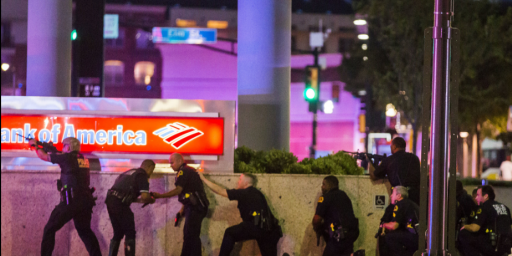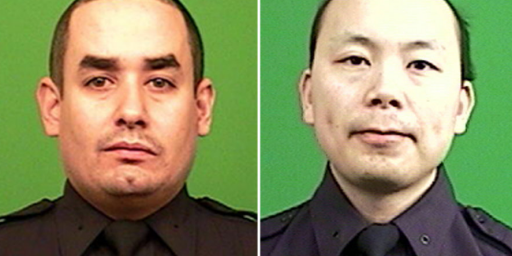Cops Violent, Educated Cops Slightly Less Violent
An academic study reveals that police officers with college education are less violent than their peers. But the real story is how violent cops are, period.
An academic study reveals that police officers with college education are less violent than their peers. But the real story is how violent cops are, period.
Weighing in on a long-simmering dispute, a recent study for the Police Quarterly shows that officers with some college education are less likely to resort to force than those who never attend college.
The study found no difference with respect to officer education when it came to arrests or searches of suspects. But it found that in encounters with crime suspects, officers with some college education or a four-year degree resorted to using force 56 percent of the time, while officers with no college education used force 68 percent of the time. “Force” included verbally threatening suspects, grabbing or punching them, using mace or pepper spray, hitting suspects with a baton, handcuffing, throwing to the ground, or pointing or firing a gun at them.
“Up until now, the studies have been much more anecdotal, indicating that education may matter,” said William Terrill, an associate professor of criminal justice at Michigan State and a co-author of the study. “We found that a college education significantly reduces the likelihood of force occurring. The difference is real. It truly is because the officer was more educated, not because the suspect was more resistant.”
Arrests, searches and the use of force are the “big three” decision-making points for police officers. The Michigan State study was the first to look simultaneously at all three vis-à-vis officer education. It found that education did not make much difference when it came to arrests and searches, confirming a number of other studies in the field. Arrests and searches are more constrained by law than the use of force.
“There’s so much more discretion with the use of force and more room for biases to play out,” Terrill said. “High-school educated officers are more apt to say, ‘I’m the law and I have the authority to make you do it, and I’m going to put my hands on you and make you do it.’ Officers with a four-year degree are more skilled at resolving problems without having to resort to force. They’re giving the citizen alternative means of compliance. They’re not just relying on the stick.”
It’s hardly shocking that smarter, better-educated cops are less likely to resort to violence. What is shocking is that they’re still using force 56 percent of the time! Granting that this is an improvement from 68 percent of the time, that’s a lot of force.
In fact, it’s so much that it struck me as implausible. Suspecting another case of an idiot journalist not understanding a scholarly study, I consulted the full text of the article (PDF here). And it’s actually worse than I thought!
The observation data were collected through a technique called systematic social observation (SSO; see Mastrofski et al., 1998, for a detailed description) in the manner of observer-participant. As an observer-participant, the researcher not only makes no effort to keep a distance from the subject they are observing (in this case, police on patrol) but also makes no effort to participate in the interactions between the observed officers and citizens (Babbie, 1995). Prior to beginning observations, field workers (students from Michigan State University and the State University of New York at Albany) took a semester-long course in SSO and participated in training rides with officers at local police departments (Terrill & Mastrofski, 2002).
The observers took notes on officer-citizen encounters, detailing the persons involved and how the encounter transpired. Following each day of field observation, the observers would transcribe their notes and enter into a SPSS data set. Officers received assurances of confidentiality and were allowed to read the notes of the researcher for which they were assigned but not the notes of researchers assigned to other officers (Parks et al., 1999).
The observation data were collected through a technique called systematic socialobservation (SSO; see Mastrofski et al., 1998, for a detailed description) in the manner of observer-participant. As an observer-participant, the researcher not only makes no effort to keep a distance from the subject they are observing (in this case, police onpatrol) but also makes no effort to participate in the interactions between the observed officers and citizens (Babbie, 1995). Prior to beginning observations, field workers (students from Michigan State University and the State University of New York at Albany) took a semester-long course in SSO and participated in training rides wit hofficers at local police departments (Terrill & Mastrofski, 2002).The observers took notes on officer-citizen encounters, detailing the persons involved and how the encounter transpired. Following each day of field observation,the observers would transcribe their notes and enter into a SPSS data set. Officers received assurances of confidentiality and were allowed to read the notes of the researcher for which they were assigned but not the notes of researchers assigned to other officers (Parks et al., 1999).
So, police officers were being followed around by observers, who were openly taking notes on each encounter. The officers saw the notes at the end of each shift. And the officers were nonetheless using force more often than not in encounters with the public?
Apparently, we need cops with postdocs.
UPDATE: Commenters Steve Plunk and PD Shaw are rightly skeptical about counting instances of “verbally threatening suspects” as “force.” I’m not a criminal justice scholar but presume this is the norm in the literature. I also presume that, since the students spent a semester training to become observers, including doing ride-alongs, that they understood how to code legitimate threats from mere stern language used to project authority.
If “verbally threatening” is being used in a reasonable manner, then it’s still worrisome to me that police are doing that on a routine basis. Again, more than two-thirds of encounters with citizens resulted in some sort of “force” being used. Even if we assume that the vast majority of these are of the manner “I’ll whomp you with my stick if you don’t shut the hell up” rather than actual stick whomping, it’s unprofessional. And all these cops aren’t assigned to the night beat in Harlem, either.
Plunk adds,
There are serious problems with modern police training. Common citizens are often treated like presumed criminals and officer safety is put ahead of the public’s safety. It’s a risky job so they should accept the risk and stop putting the public at risk. Training should start with teaching police officers who they serve and why citizens should be given the utmost respect.
I think that’s basically right. At least in the popular culture, that was always the norm until the age of Dirty Harry and Hill Street Blues; the degree to which Joe Friday ever reflected reality is open to debate. But the default attitude of police officers seems to be Us vs. Them, with everyone not in uniform in the latter camp. It’s a dangerous model.







Verbally threatening is counted as using force? Might as well throw the whole study away then. Police are trained to use their voice and physical presence to control any and every conversation with the public. I don’t agree with such training but calling it violence undermines the report.
There are serious problems with modern police training. Common citizens are often treated like presumed criminals and officer safety is put ahead of the public’s safety. It’s a risky job so they should accept the risk and stop putting the public at risk. Training should start with teaching police officers who they serve and why citizens should be given the utmost respect.
James, I think they are defining force to include non-physical threats:
“force, is defined as acts that threaten or inflict physical harm on citizens.”
Elsewhere, it makes clear that force can be verbal or physical.
That seems to create a lot of subjectivity.
Well, we could always send Joyner, with his PhD, down some dark alley to flush out an armed drug dealer. Or better still, we could replace Joyner with an illegal alien and send HIM down the alley. Some jobs will NEVER pay enough and Joyner should know better after serving in a war zone.
@John425
I volunteered to serve in a war zone. Or, at least, to be subject to being sent there. And I was expected to follow the laws of war, the code of conduct, the UCMJ, and the rules of engagement regardless of whatever level of anxiety I was feeling.
Similarly, cops sign up for the job. They’re allowed to defend themselves but not preemptively use force and threats on citizens because they’re scared.
I once dated a journalist whose first job out of college was the police beat, for which she did drive arounds with the police at night. I would describe her as very liberal, but after several weeks, she had come to believe in alcohol prohibition. The night patrols were packed with belligerent drunks, shouting, threatening and/or violent. And as I recall that was the point of her going on night patrols — they were data rich and the police (and the reporter) wanted the action to be viewed.
I don’t see anything in the report that tells time of day the patrols ran, but doing them between midnight and four will get the researcher a lot of data
In short, I guess I’d have to see entire incidents from beginning to end (not to mention have a thorough understanding of police conduct codes) to accurately judge here. Statistics are hard enough to interpret without lumping together verbal ‘threats’ and shooting in the same category.
The larger point remains interesting about the education of the officers. A good follow-up would be to determine if the more-educated cops were just as effective in achieving the specific goals of each encounter (arresting without any innocent bystanders getting hurt, obtaining useful evidence or statements, etc.). More difficult to analyze, for sure, but sometimes a dog needs to be treated like a dog.
> There are serious problems with modern police training. Common citizens are often treated like presumed criminals and officer safety is put ahead of the public’s safety. It’s a risky job so they should accept the risk and stop putting the public at risk. Training should start with teaching police officers who they serve and why citizens should be given the utmost respect.
Pretty much spot on. This is a subject right & left seem to agree on and we should look at ways to change this situation.